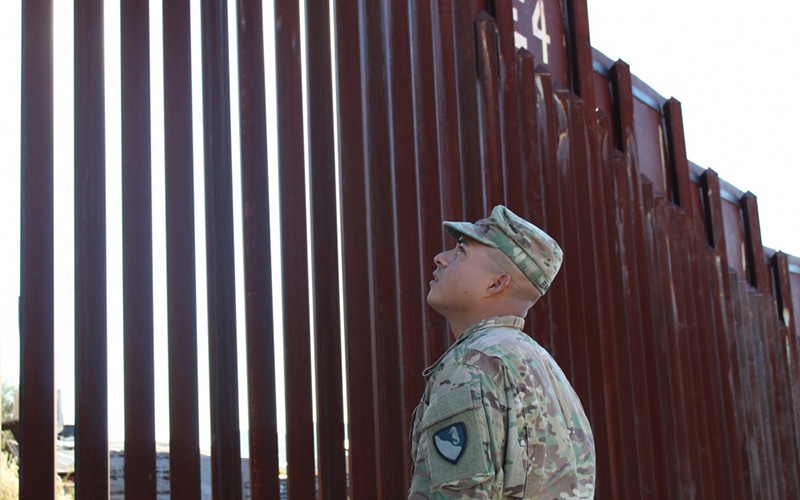
Sgt. Fabian Barreto, 104th Engineer Construction Company, surveys the border barrier along the Arizona-Mexico border in November as part of the Pentagon’s support of border-security operations. The Defense Department said it is sending 3,750 more troops to the border in the effort. (Photo by 2nd Lt. Corey Maisch/U.S. Army)
WASHINGTON – The Defense Department said it will send an additional 3,750 active-duty troops to the southern border to support Customs and Border Protection officers by stringing razor wire, helping operate mobile surveillance equipment and other support activities.
The 90-day deployments will bring the number of active military on the border to 4,350, an announcement that came just days before President Donald Trump’s State of the Union speech Tuesday in which border security is likely to play a large part.
It also came as Trump again raised the specter of caravans of Central American migrants heading north through Mexico toward the U.S. border, as he did in October when the first active-duty troops were deployed there.
Although he did not specifically mention troops in a Sunday tweet, Trump called on Republicans to protect the border “with caravans marching through Mexico and toward our Country.”
But Sheriff Tony Estrada of Santa Cruz County, which runs along the border east and west of Nogales, said the call for more troops at the border is little more than an “exaggeration by the current administration,” which is wrongly giving the border “the image of a war zone.”
This deployment is an extension of a Trump policy that began in April, when the president called on border-state governors to send National Guard troops to assist Department of Homeland Security operations there. Nearly 2,100 guardsmen eventually were deployed, funded by federal dollars.
In October, the president ordered the deployment of the first active-duty soldiers, an operation that peaked at 5,900 troops. That number gradually tapered off until Sunday’s announcement.
In an email Monday, Capt. Bill Speaks, a Pentagon spokesman, said the deployment follows up on a troop authorization approved Jan. 11 by acting Defense Secretary Patrick Shanahan. He said the troops will provide support to Customs and Border Protection that “includes a mobile surveillance capability through the end of September 2019, as well as the emplacement of approximately 150 miles of concertina wire between ports of entry.”
No troops, whether active or guard, can be involved in the apprehension of immigrants but can only offer support services, such as maintaining vehicles, manning surveillance equipment and helping fortify border barriers and ports of entry.
Chris Montoya, a retired Border Patrol agent, said there were times when National Guard troops helped on the border, citing a time when a guardsman knew how to fix underground border sensors, something his agents did not know how to do.
Aside from that, however, he said soldiers may not be the best help at the border because of the way the military is trained. He said the military “has a different mindset … it doesn’t really apply to civilian policing.”
“Migrants and military don’t mix,” said Montoya, who was in Washington Monday as part of a Cato Institute panel on border security. “They are trained to fight an enemy … they are going to get bored over time. Will they begin to perceive migrants as the enemy?”
Patrick Eddington, a Cato Institute analyst on homeland security and civil liberties, was more critical, calling the deployments unnecessary and “emblematic of this administration’s failed approach to immigration reform.”
“Instead of spending time at home with their families between deployments, a brigade of American soldiers will be erecting still more razor wire and deploying surveillance systems that can be used against not only border crossers, but potentially Americans living in the border region,” Eddington said in an email.
The latest deployment “will only disrupt the lives and livelihoods of Americans in the border region, while doing nothing to fix America’s broken immigration system,” he said.
But in testimony to the House Armed Services Committee last week, two top Pentagon officials defended the deployments, saying they have helped Customs and Border Protection “to do their duties at ports of entry.”
Defense Undersecretary for Policy John Rood and Vice Adm. Michael Gilday also said the Pentagon has “a long history of supporting efforts to secure U.S. borders,” beginning in the early 1990s. That was echoed by Rep. Mac Thornberry, R-Texas, who said the latest deployments are in line with “the sort of things that we have asked the military to do for a long, long time.”
But Rep. Adam Smith, D-Wash.,said he was “deeply troubled” by last week’s testimony, which included no hint of additional deployments on the same day that Shanahan was predicting that the border operation would require “several thousand” more troops. Smith, the chairman of the committee, said that was despite the fact that committee members asked Rood and Gilday “multiple times” about future deployments.
“They never mentioned it,” Smith said in a letter to Shanahan last week. “This was at best an error in judgment, and at worst flat-out dishonesty.”
Other border-county sheriffs who have been generally supportive of troops’ presence did not immediately return calls seeking comment Monday on the latest deployment.
But Estrada said the whole effort is misplaced, saying that talk of “wire and a wall is a distraction.”
“(The) impression of a war zone is not fair, right or true,” the sheriff said. “We have a friendly border and friendly neighbors.”